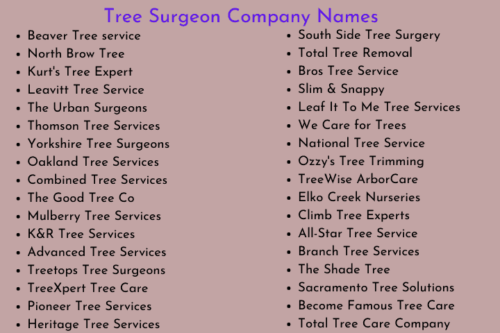Start a Tree Service Business can be a rewarding venture, but it requires careful planning and execution. Here are the key steps to consider:
-
Gain the Necessary Skills and Knowledge:
- Education and Training: Understanding tree biology, safe tree removal techniques, and proper pruning methods is crucial. You may need to take courses or gain certifications in arboriculture.
- Experience: Working in the industry before starting your own business provides valuable experience.
-
Business Planning:
- Business Plan: Create a detailed business plan outlining your services, target market, pricing strategy, and financial projections.
- Legal Structure: Decide on the legal structure of your business (e.g., sole proprietorship, LLC, corporation) and register your business with the appropriate authorities.
- Insurance and Licensing: Obtain the necessary insurance to protect your business and employees. Check local regulations for any required licenses or permits.
-
Equipment and Tools:
- Invest in Quality Equipment: This includes chainsaws, ladders, safety gear, a wood chipper, and possibly a truck or trailer for transportation.
- Maintenance: Regular maintenance of your equipment is essential for safety and efficiency.
-
Marketing and Building a Clientele:
- Branding: Develop a strong brand identity with a company name, logo, and possibly a website.
- Marketing Strategy: Utilize online marketing, social media, and local advertising to reach potential clients.
- Networking: Connect with local businesses and homeowners to build your clientele.
-
Safety and Training:
- Safety Protocols: Implement strict safety protocols to protect your employees and clients.
- Continuous Training: Keep up with industry standards and provide ongoing training for your team.
-
Financial Management:
- Pricing Strategy: Set competitive prices for your services while ensuring profitability.
- Accounting and Taxes: Keep accurate financial records and stay on top of tax obligations.
-
Customer Service and Reputation:
- Quality Service: Provide high-quality, reliable service to build a strong reputation.
- Customer Feedback: Encourage customer feedback and use it to improve your services.
-
Growth and Expansion:
- Reinvesting in the Business: Reinvest profits to grow your business, whether through marketing, new equipment, or hiring additional staff.
- Diversifying Services: Consider offering related services, such as landscaping or tree planting, to expand your client base.
Best Tree Service Business Names
Choosing a great name for your tree service business is crucial as it sets the first impression and reflects the nature of your services. Here are some creative and catchy business name ideas for a tree service company:

- Evergreen Elite Tree Care
- Majestic Arbor Services
- Timber Titans Tree Experts
- Arbor Artisans Tree Solutions
- Skyline Tree Specialists
- Nature’s Guardians Tree Service
- Green Canopy Pros
- Branch Masters Tree Care
- Leaf & Limb Crafters
- TreeTop Triumph Services
- Verdant Vistas Tree Experts
- Roots & Shoots Arbor Care
- Sylvan Sage Tree Services
- Woodland Wonders Tree Care
- EcoTree Elite Services
- Forest Frontier Tree Experts
- ArborWise Tree Professionals
- Crown & Branch Tree Specialists
- Leafy Legends Tree Services
- Canopy Kings Arbor Care
These names are designed to be memorable and suggest quality, care, and expertise in tree maintenance and arboriculture.
How to bid tree jobs?
Bidding on tree jobs, like any contracting work, requires a careful approach to ensure that you provide a competitive yet profitable quote. Here’s a general guide on how to bid tree jobs:

- Understand the Job Requirements: Before placing a bid, thoroughly understand what the job entails. This includes the type of trees (size, species), the number of trees, the type of work needed (trimming, removal, stump grinding), and the job’s location.
- Site Visit: If possible, visit the site to assess the trees and the work needed firsthand. This will allow you to identify any potential challenges or risks, such as power lines, property lines, and access issues.
- Estimate Time and Labor: Based on the job requirements, estimate how long the job will take and how many workers will be needed. Consider the complexity of the work, such as the height of the trees and the need for special equipment.
- Calculate Equipment and Overhead Costs: Include the cost of any equipment you will need to rent or use, such as chainsaws, chippers, or cranes. Also, factor in overhead costs like insurance, fuel, and maintenance.
- Safety Measures: Tree work can be dangerous. Ensure that you include the cost of safety equipment and measures in your bid.
-
Waste Disposal:
Consider the cost of disposing of tree waste, whether you’ll be chipping it on-site or hauling it away. - Profit Margin: Add a profit margin to your costs. This will vary depending on the market and your business goals, but a typical margin might be around 15-20%.
- Prepare a Detailed Quote: Provide a detailed written quote to the client. It should clearly outline the scope of work, the time frame, the total cost, and any terms and conditions.
- Flexibility and Negotiation: Be prepared to negotiate with the client. Sometimes, you may need to adjust your bid based on their budget or other contractors’ bids.
- Legal and Contractual Aspects: Make sure your bid complies with any local regulations or licensing requirements. Once the bid is accepted, draft a contract that outlines the agreement’s specifics.
Remember, each job is unique, and your approach may need to be adjusted accordingly. It’s also a good idea to keep records of your bids and the actual costs and time taken to complete the jobs. This historical data can help you make more accurate bids in the future.
